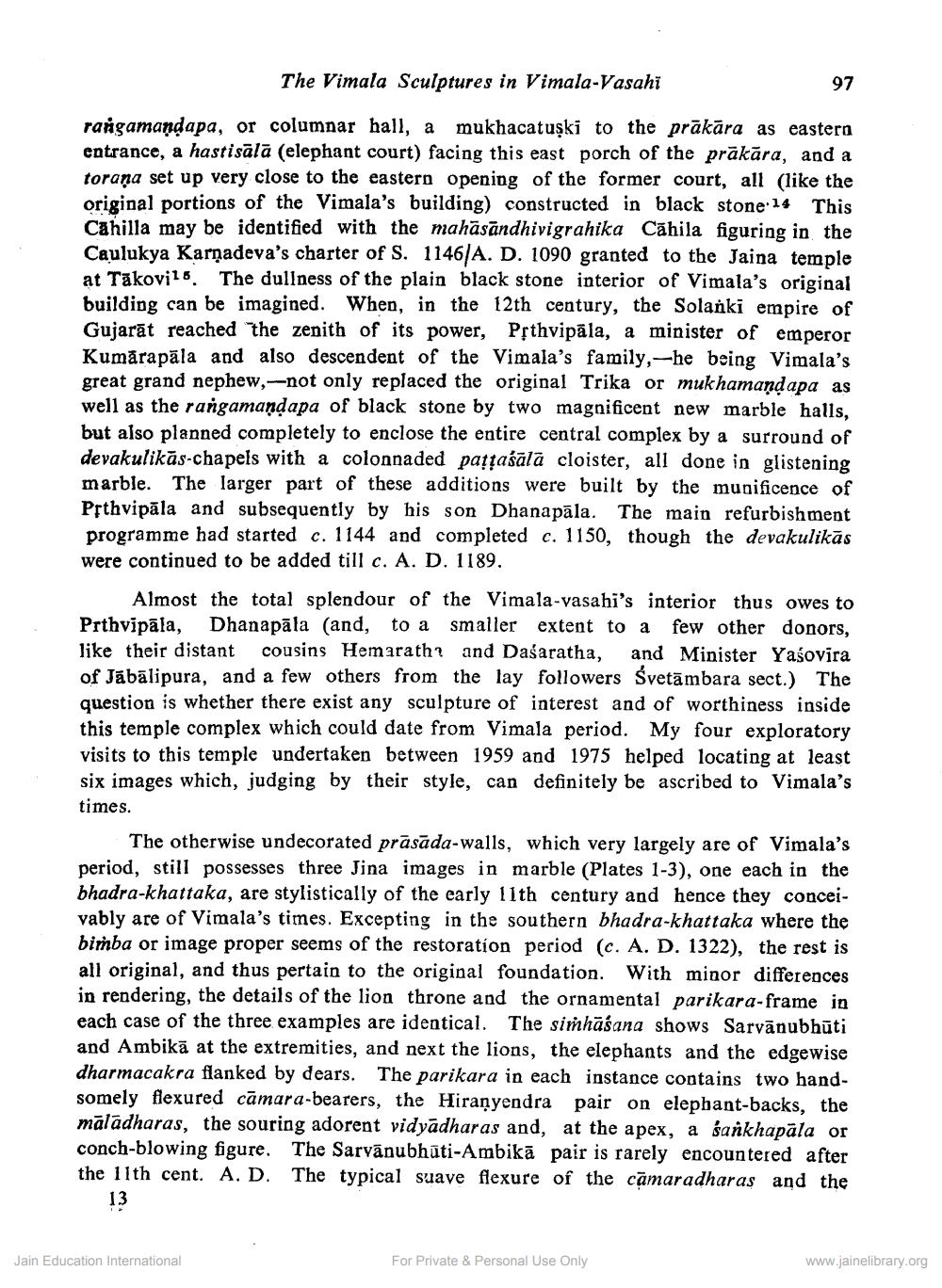Book Title: Vimala Period Sculptures in Vimal Vashi Author(s): M A Dhaky Publisher: Z_Aspect_of_Jainology_Part_2_Pundit_Bechardas_Doshi_012016.pdf View full book textPage 2
________________ The Vimala Sculptures in Vimala-Vasahi 97 rangamandapa, or columnar hall, a mukhacatuṣki to the prākāra as eastern entrance, a hastisālā (elephant court) facing this east porch of the prākāra, and a torana set up very close to the eastern opening of the former court, all (like the original portions of the Vimala's building) constructed in black stone:14 This Cahilla may be identified with the mahāsāndhivigrahika Câhila figuring in the Caulukya Karnadeva's charter of S. 1146/A. D. 1090 granted to the Jaina temple at Tākovill. The dullness of the plain black stone interior of Vimala's original building can be imagined. When, in the 12th century, the Solanki empire of Gujarāt reached the zenith of its power, Pșthvipāla, a minister of emperor Kumārapāla and also descendent of the Vimala's family,--he being Vimala's great grand nephew,--not only replaced the original Trika or mukhamand apa as well as the rangamandapa of black stone by two magnificent new marble halls, but also planned completely to enclose the entire central complex by a surround of devakulikās-chapels with a colonnaded patțaśālā cloister, all done in glistening marble. The larger part of these additions were built by the munificence of Prthvipāla and subsequently by his son Dhanapāla. The main refurbishment programme had started c. 1144 and completed c. 1150, though the devakulikās were continued to be added till c. A. D. 1189. Almost the total splendour of the Vimala-vasahi's interior thus owes to Prthvipāla, Dhanapāla (and, to a smaller extent to a few other donors, like their distant cousins Hemarathi and Dasaratha, and Minister Yasovira of Jābālipura, and a few others from the lay followers Svetāmbara sect.) The question is whether there exist any sculpture of interest and of worthiness inside this temple complex which could date from Vimala period. My four exploratory visits to this temple undertaken between 1959 and 1975 helped locating at least six images which, judging by their style, can definitely be ascribed to Vimala's times. The otherwise undecorated prāsāda-walls, which very largely are of Vimala's period, still possesses three Jina images in marble (Plates 1-3), one each in the bhadra-khattaka, are stylistically of the early 11th century and hence they conceivably are of Vimala's times. Excepting in the southern bhadra-khattaka where the bimba or image proper seems of the restoration period (c. A. D. 1322), the rest is all original, and thus pertain to the original foundation. With minor differences in rendering, the details of the lion throne and the ornamental parikara-frame in each case of the three examples are identical. The simhāśana shows Sarvānubhūti and Ambikā at the extremities, and next the lions, the elephants and the edgewise dharmacakra flanked by dears. The parikara in each instance contains two handsomely flexured cāmara-bearers, the Hiraṇyendra pair on elephant-backs, the māladharas, the souring adorent vidyadharas and, at the apex, a śankhapāla or conch-blowing figure. The Sarvānubhūti-Ambikā pair is rarely encountered after the 11th cent. A. D. The typical suave flexure of the camaradharas and the 13 Jain Education International For Private & Personal Use Only www.jainelibrary.orgPage Navigation
1 2 3 4 5 6 7 8 9 10 11 12
